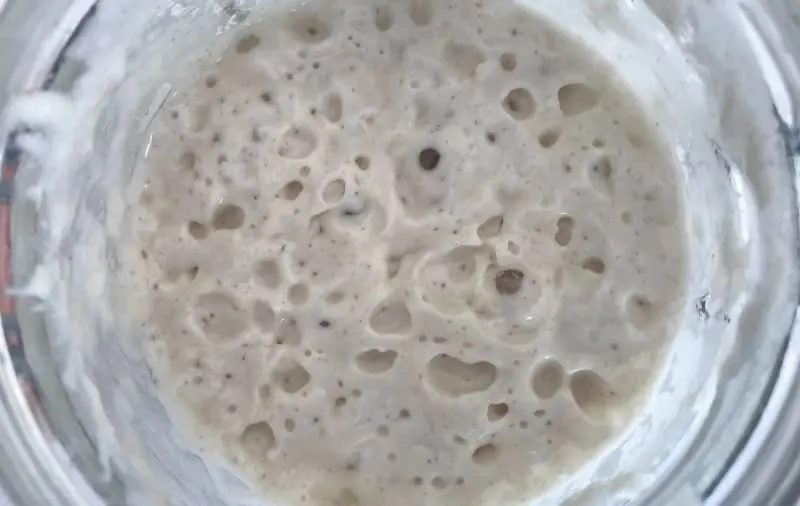Sourdough starters are made out to be extremely difficult to use properly, but that’s not exactly true.
Once you get a better understanding of your starter and experiment with it, you’ll quickly realise that it’s not really that back-breaking to use it effectively.
You can use your sourdough starter straight from the fridge whether it has been fed or not. Whilst a recently fed starter will be more effective, a starter that hasn’t been fed for a few days will still rise your dough. You may want to let it get to room temperature for slightly faster fermentation.
I remember when I first made my starter, I kept to a strict feeding schedule and got worried whenever I fed it too late. I remember thinking that it wouldn’t rise my bread if it wasn’t at its peak. I was very misguided.
Since then, I’ve learned a lot about sourdough starters and now know that they’re not the most fragile things in the world.
They can take being forgotten about for a month and get back to their normal selves within a week. You can use them both before and after they’re peaked with good results. It’s not going to ruin your bread if you don’t use it when it’s at peak activity.
Do You Feed Your Sourdough Starter Before You Use It?
Providing that your sourdough starter is healthy, it’s going to be pretty strong and forgiving if you don’t use it at its peak.
With that said, there’s definitely a time to use for optimal results, so it’s important that you figure out when your starter is at peak activity.
For the best results, you should feed your sourdough starter 4-12 hours ahead of using it (depending on the type of flour and temperature). This allows it to reach its peak activity. The starter does not need to be fed right before use.
During this 4-12 hour period, your starter will rise and fall. If you catch it at the right time, you’ll be able to get a faster rise and great ovenspring.
The ideal time to use it is when it’s reached its max height, and just before it starts to deflate again. You’ll most likely see a surface full of bubbles at this point if you’re using a 100% hydration starter.
This point of the sourdough starter’s cycle is when the bacteria have consumed most of their ‘food’ and can therefore not produce any more gas.
This is the best time because the bacteria are just starting to become less active, so putting it into some fresh dough will provide them with more food and therefore keep them active.
Using An Unfed Starter Straight From The Fridge
For the experiment in the video above, Sune used two starters to make sourdough bread. One starter was freshly fed and the other had been sitting in the fridge for two weeks unfed.
As you can probably guess, these two starters gave different results, but what you might not have expected is that both starters produced great bread.
The key takeaways from the experiment are:
- The dough with an unfed starter had less oven spring and took considerably longer to proof.
- The unfed starter produced a loaf that was sourer and can therefore be used to make bread tangier.
- An unfed starter CAN effectively rise the sourdough (even after two weeks in the fridge).
So, there’s no doubt about it that a sourdough starter that’s coming straight from the fridge, whether fed or unfed, can still be used to rise dough.
An unfed starter that’s coming straight from the fridge will take longer to get going and it will have a more sour flavor, but it will still manage. Just be patient with it and you’ll be fine.
A starter that’s been fed and refrigerated will be better at rising dough still. Since it’s been fed, it should still be healthy and have some good activity, but the rise may be slightly longer since it’s going to lower the temperature of the dough overall.
How Long Does Sourdough Starter Last In The Fridge?
Your sourdough starter might need feeding on a daily basis, but you can get away with a bit of neglect if you’re going to be storing it in the fridge.
If you’re a regular sourdough baker, a starter can be fairly high maintenance since you need to feed it twice a day, but if you don’t make sourdough all that often, you’ll be able to leave it in the fridge for a while.
You can actually get away with forgetting about your starter for longer than you might expect when it’s in the fridge.
Mature wheat sourdough starters can last at least 2 weeks and up to 2 months in a cold fridge before needing to be fed. Mature rye starters have a much longer life of at least 30 days and up to several months before they need to be fed.
With that said, it’s important that you build a mature starter that’s healthy before you go ahead and store it in the fridge for long periods of time.
You should aim to feed your starter daily for at least 2 months so you can get it to be mature and make sure that it’s in good health. Only then should you put it in the fridge.
You will likely be able to store it in the fridge before this 2 month mark, but it’s better to be safe and sorry by getting it to a really strong and healthy state.

